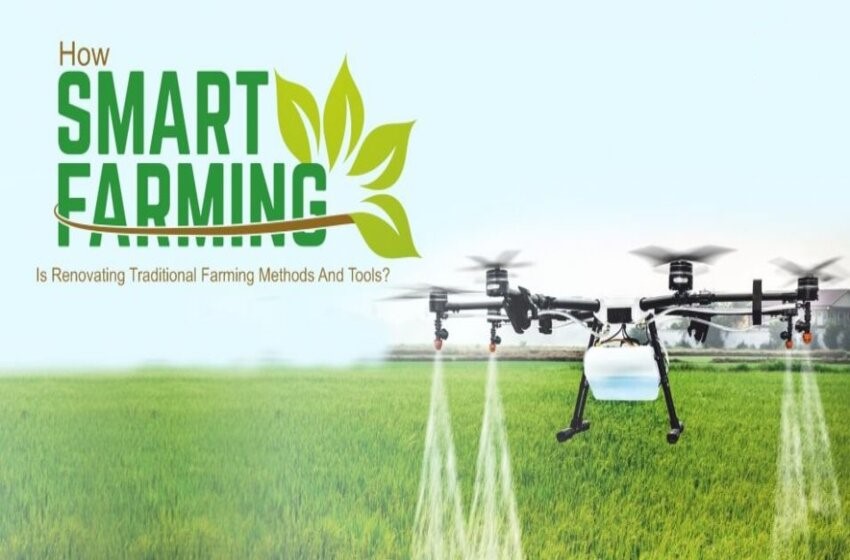
Smart Farming: Why Is It Important In Agriculture?
- Business Startup
 Niccolo Romano
Niccolo Romano- August 16, 2021
- 1
- 8 minutes read
Smart farming is aimed at the use of data that is collected via several sources in the activities related to the management of farms. Any technically advanced element doesn’t essentially call them smart. Smart systems differentiate and set themselves apart through their ability to record data and bring meaning out of it. Smart farming includes Software (Saas) and Hardware (IoT) to accumulate data and offer actionable information so that all functions of the farm can be managed in both pre and post harvest conditions. The data is accessible, organized, and offers all information related to farming.
How Is Smart Farming Different From Traditional Farming?
Traditional farming is the most used form of framing around the globe. It is based on providing the plants and soil with products that are more likely to be natural and not produced synthetically. Technological advancement is not involved much in this form of farming.
For the cultivation of crops, this form employs the same set of practices. This form of agriculture requires manual maintenance of finance and field separately which may lead to errors as well. Whereas in smart farming each farm is analyzed individually to see the appropriate crops and the requirement of water for optimization. Also, it detects the affected areas and works on them which saves a lot of costs.
The smart farming companies enable satellite imagery that can successfully detect the varied farm zones. But in the case of traditional farming, there is no option for geo tagging and detection of zones.
Smart farming is very efficient in predicting the weather which cannot be done in the traditional farming mechanism.
With the advent of smart farming ideas, the farming sector has taken a leap. There are many startups that are working on this to provide a better farming environment for the farmers.
How Do Robotics And Automations Help?
Internet of Things (IoT) in farming include drones, sensors, and robots that are connected through the internet which operates semi automatically and automatically doing operations and assembling data that is focused on increasing the predictability and efficiency. In the increase in demand and shortage of labor throughout the world, agricultural automation and robots, which are also known as Agribots, are beginning to receive attention among the farmers’ group. There was a decrease in the production of crops by approximately $3.1 billion in the USA in a year only because of the shortage of labor. Recent developments in AI and sensor technology that allows machines to train in their surroundings have contributed more to the fame of agribots. The world is presently at the early stage of the agrobotics revolution with maximum products still in the trial phase.
With the advent of smart farming, semi automatic robots with arms can successfully detect weeds and also spray pesticides in the plants that are affected which saves the plants and also the cost of all pesticides. They can also be used in lifting and harvesting. Heavy farming vehicles can also be availed from the comfort of homes through your smartphones to perform operations and their positions can be traced with GPS at every time.
Drones that are equipped with cameras and sensors are used for mapping, imaging, and surveying the fields. They can be controlled remotely or they can automatically fly through flights that are software-controlled planes in their embedded systems, working in accordance with GPS and sensors. From the drone data, insights can be gathered regarding crop irrigation, health, planting, spraying, soil and field, plant counting and yield prediction, and many more.
Disadvantages Of Smart Farming
The smart farming IoT is thought to be the main driving factor in the transformation in agriculture. These devices allow the farmers to track their crops and all the other activities that are related to that in real time with precision farming, smart greenhouse management, and livestock management. But along with boons it also comes with a ban, and here are the disadvantages of smart farming.
- Smart farming continually needs an internet connection. Smart farming in India and other developing countries did not abide by those criteria and the internet is slower.
- The IoT related equipment enables the farmer to evaluate the use of technology and to learn. It is the biggest drawback for the large-scale operations of smart framing.
- Given any security measures, the system provides little power and can lead to various kinds of network glitches.
- It is very complicated to decide, build, manage and enable the broad idea of the IoT framework.
Conclusion
Smart farming aims at the application of data acquiring and assembling it from different sources of data to view the bigger picture to be able to manage all the operations in the farm. It is said to be a big leap from traditional agriculture as it offers predictability and certainty to the table. Cloud software and robotic automation are the smart agriculture tools. Drones, robotics, and sensor equipment that is kept throughout the farm can collect data and this data is processed to offer insights into the farm.


1 Comment
Bravo, what phrase…, a brilliant idea